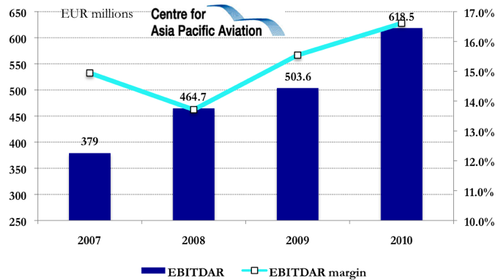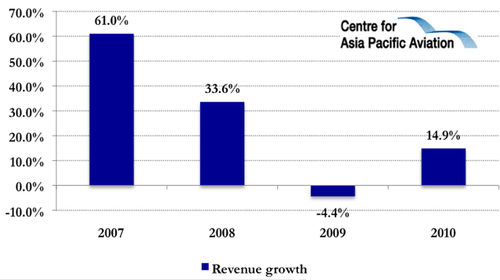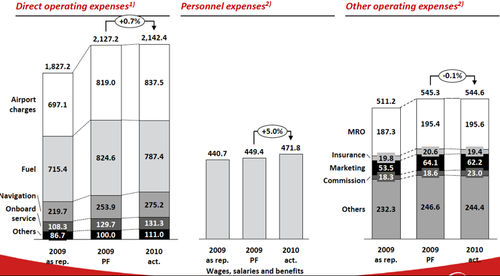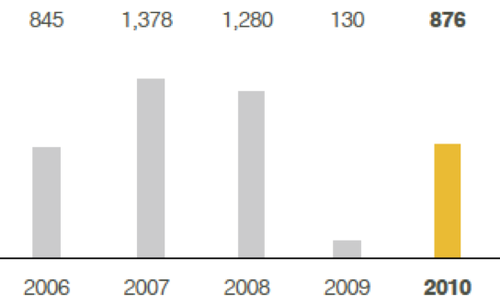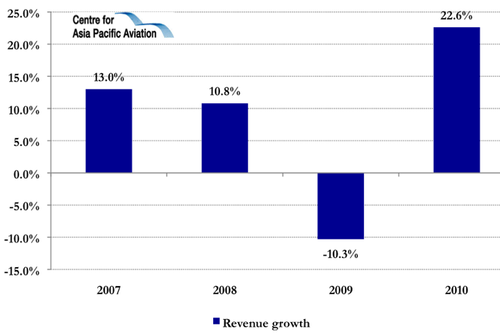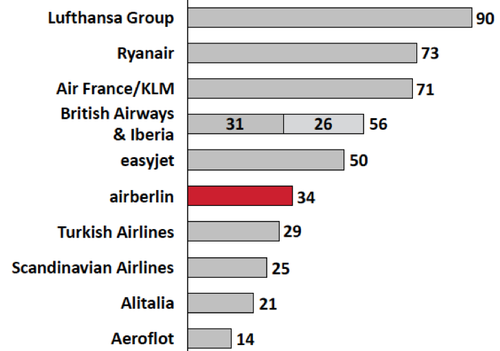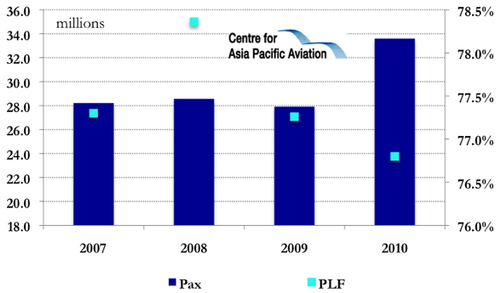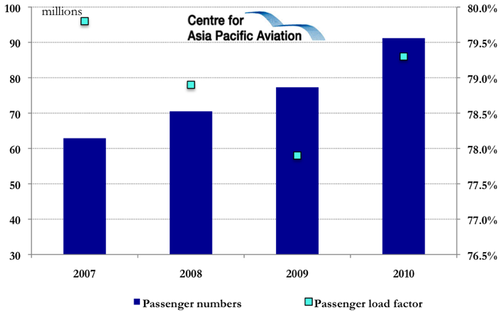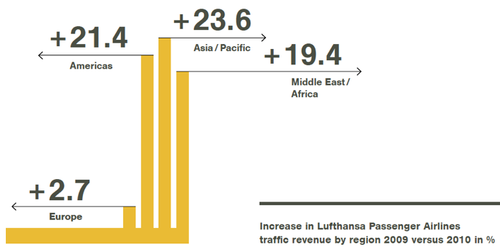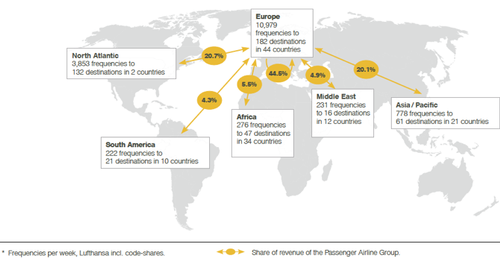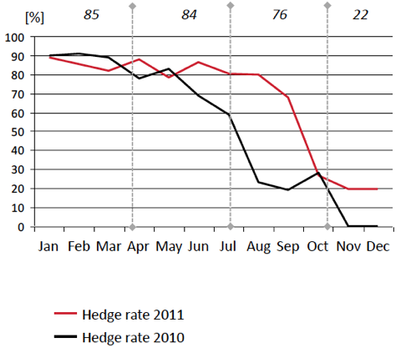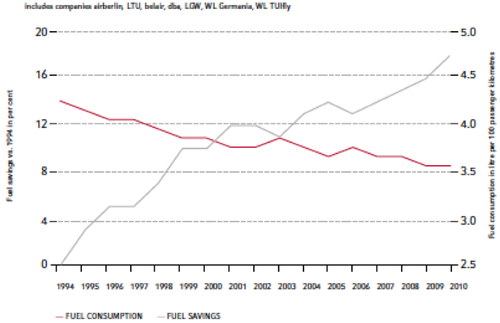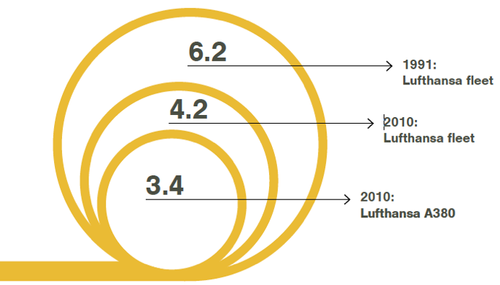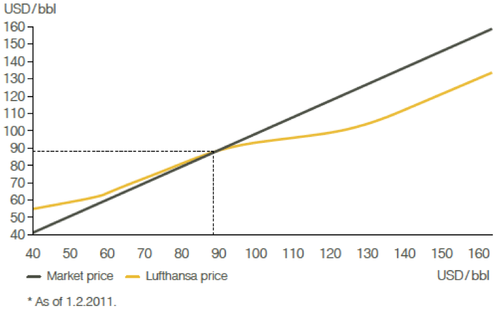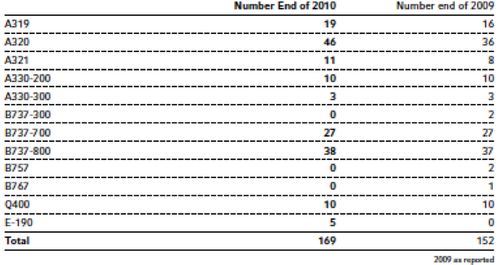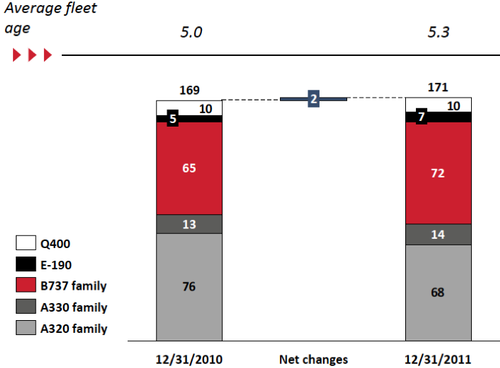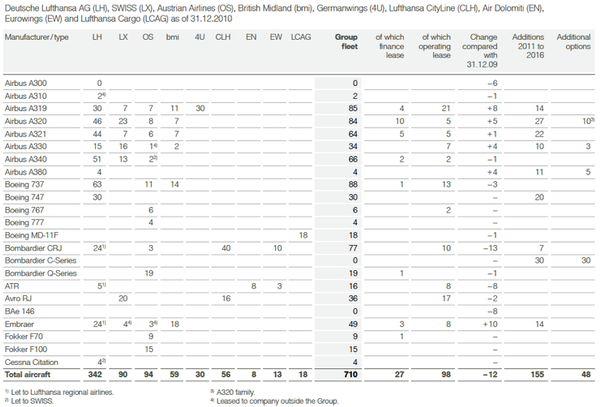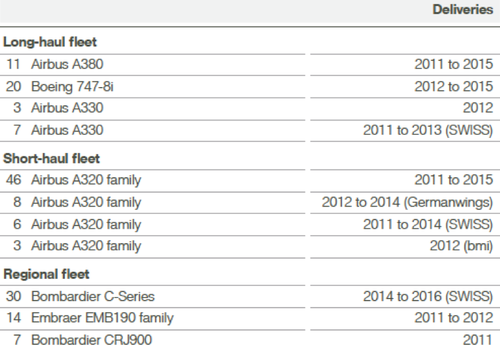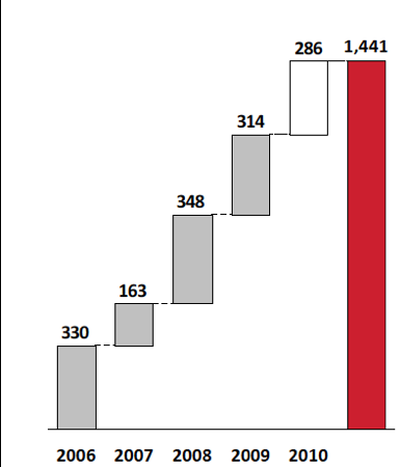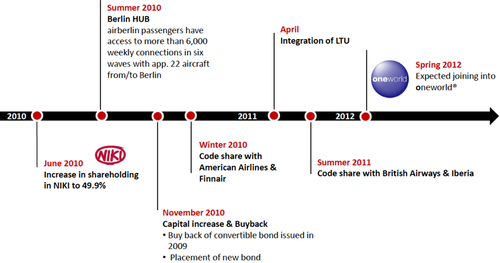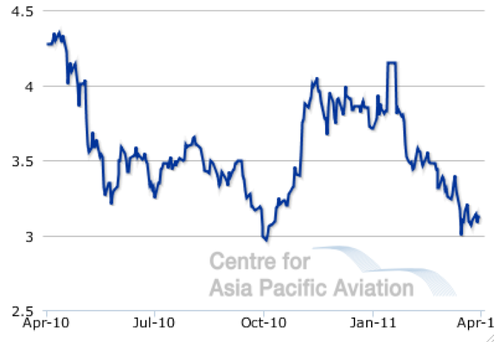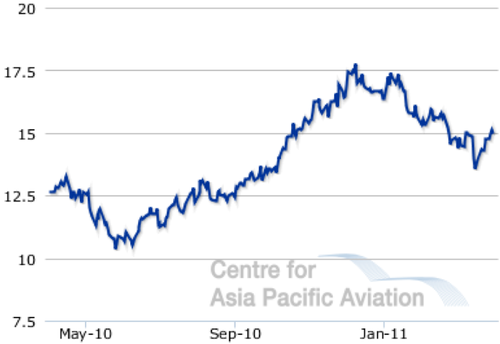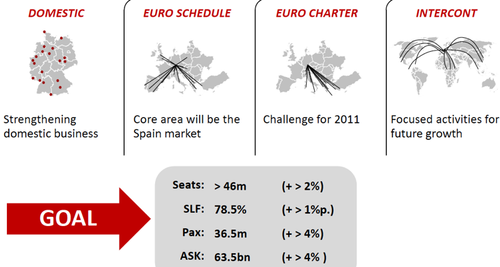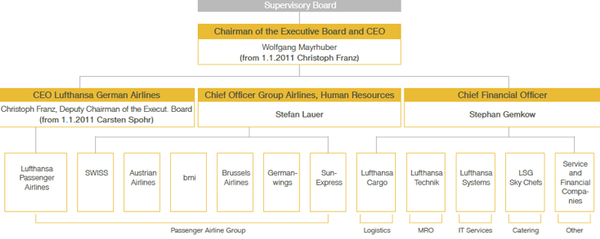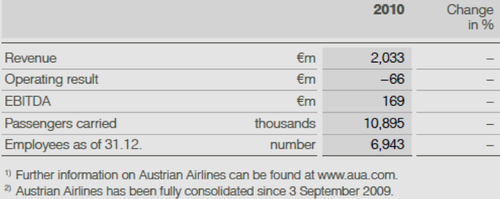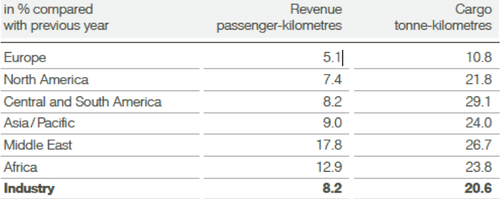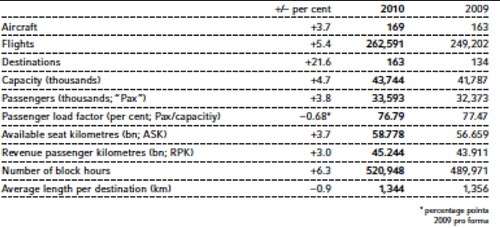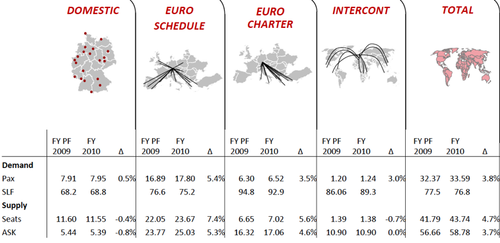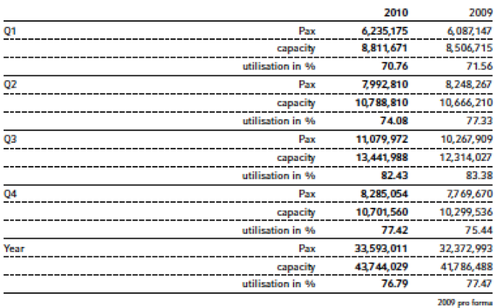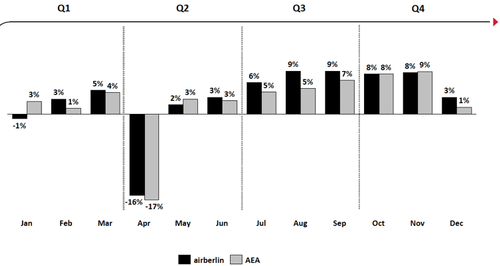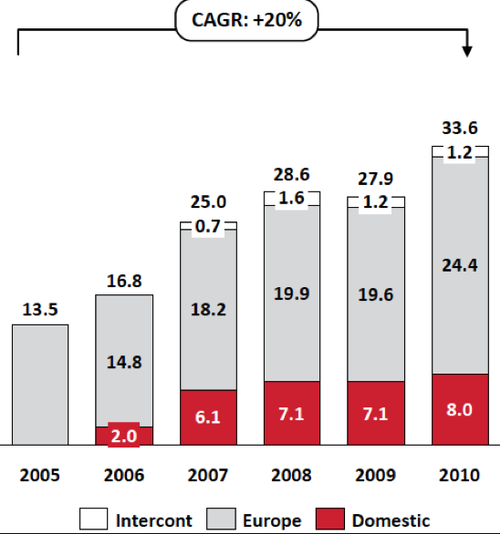Air Berlin predicts return to profit; Lufthansa expects improved 2011 result
Air Berlin, Germany's second largest airline, predicted a return to profit in 2011 as economic growth, a decline in unemployment and increasing demand for business travel boosts passenger numbers. "The good economic development is strengthening demand for business travel but it helps tourism as well," CEO Joachim Hunold said.
Meanwhile, Lufthansa chairman Christoph Franz stressed that "2011 will not be a walk in the park" despite forecasting improved operating profits and revenues for 2011 and a "bright" economic outlook for the year. The carrier, which noted that it has again "created value" in 2010, cautioned that competition is intensifying on routes in Europe, Asia and the Americas and expressed concerns related to wage talks.
In addition, Lufthansa noted that the German air traffic tax "is an unpleasant blow", a concern also raised by Air Berlin. A sharp rise in fuel costs could also hurt the carriers' profits, even as the economic recovery is expected to boost the airlines' revenues and operating profit.
Air Berlin to post profit in 2011 after disappointing loss in 2010
Air Berlin, which did not provide a net income forecast for this year, aims to post a profit next year "at the latest", the CEO said. The carrier reported a "disappointing" EUR97.2 million net loss in 2010, with Mr Hunold stating the carrier was "not satisfied with the profit developments" in the year.
Air Berlin is forecasting EBIT will be positive this year, after a EUR9.3 million loss in 2010. This compared with a positive EBIT of EUR28.5 million in 2009. The carrier's net loss also widened in 2010, to EUR97.2 million, up from a loss of EUR9.5 million in 2009. EBITDAR improved 22.8% to EUR618.5 million.
Air Berlin EBITDAR and EBITDAR margin: 2007 to 2010
Earnings were negatively affected in 2010 by reduced yields, heavy snowfalls, ATC strikes and the volcanic ash cloud from Iceland that closed airports. The Dec-2010 snowstorms resulted in the cancellation of approximately 800 Air Berlin flights. The carrier also reported losses from the valuation of derivative financial instruments and lower foreign exchange gains as well as to the costs of buying back convertible bonds.
Also in 2010, Air Berlin's revenues increased 14.9% to EUR3.7 billion, while operating costs increased 16.6% to EUR3.8 billion. Unit costs declined 1.9% with cost per ASK excluding fuel declined 0.7%. Air Berlin's net debt had decreased 15% to EUR489.2 million at the end of Dec-2011 from EUR574.1 million a year earlier.
Air Berlin revenue growth: 2007 to 2010
Operating expenses growth: 2009 vs 2010
Lufthansa reports improved profit in 2010, trend to continue
Lufthansa reported a "successful" year in 2010, swinging to a 2010 net profit of EUR1.1 billion following a loss of EUR34 million in 2009, boosted by a EUR400 million one-off tax effect.
CEO Christoph Franz described the year 2010 as an eventful and challenging, yet ultimately successful. "We can be highly satisfied with this result; it shows that we have learned from the crises of the past," he said. "The company expects a further increase in revenue and the operating result, and as things currently stand, the conditions for a dividend payout should also be fulfilled for this year," the carrier stated. Lufthansa will pay a 2010 dividend of EUR0.60 cents/share.
During 2010, Lufthansa benefitted from a rebound in international passenger and freight traffic, the positive effects of cost cutting measures and from realising further synergy potential within the group. Lufthansa's operating profit stood at EUR876 million in the full year, a 20.4% year-on-year increase, on revenues of EUR27.3 billion, a 22.6% year-on-year increase.
Lufthansa operating profit (EUR mill) development: 2006 to 2010
Traffic revenue increased 26.5% to EUR22.3 billion. The adjusted figures without the consolidation effects increased by 14.4% (revenue), 16.2% (traffic revenue) and 12.6% (operating income). Operating expenses rose 16.7% in 2010, driven by a 41.5% jump in fuel costs, which was both price and volume related.
Lufthansa Group revenue growth: 2007 to 2010
The carrier's operating expenses increased 16.7% to EUR28.9 billion. The carrier has a target of marking sustainable savings of EUR1 billion by the end of 2011, with costs reduced by around EUR230 million in 2010.
Lufthansa raises expectations for acquisition synergies
Swiss International Air Lines tripled the 2009 result to record an operating profit of EUR298 million. The overall result of the Passenger Airline Group also included operating losses of EUR66 million from Austrian Airlines and EUR145 million from British Midland. Both airlines continue to consistently implement the introduced restructuring measures. Germanwings continued on its course of growth. However, the one-time special effects of the past year resulted in a negative operating result of EUR39 million.
Lufthansa Group finance director Stephan Gemkow stated Lufthansa has raised its expectations for synergies from the acquisitions of Austrian Airlines and British Midland Airways. Mr Gemkow said that synergies from the takeover of Austrian Airlines are now expected to reach around EUR130 million p/a compared with the previous estimate of EUR100 million p/a. Synergies from the acquisition of bmi have been raised from EUR20 million p/a to EUR30 million p/a.
Air Berlin handles record 33.6 million pax in 2010
In 2010, Air Berlin handled a record 33.6 million passengers, making the so-called hybrid carrier the second largest carrier in Germany and the sixth largest in Europe. The carrier stated that it witnessed strong growth in business passengers in 2010, particularly corporate customers. Load factors slipped 0.7 ppts to 76.8% in the year. RASK declined 2.6% to EUR 6.33 cents. (See appendix below for more traffic data information).
European carrier passenger numbers 2010
Air Berlin passenger numbers and passenger load factor: 2007 to 2010
Air Berlin's passenger numbers will grow by 4-5% in 2011, driven by international expansion, with increased frequencies to New York, San Francisco and Vancouver, the carrier said. Air Berlin had a "weak start" in the first quarter after tourists cancelled flights to Tunisia and Egypt because of the political unrest. Capacity to those countries will be reduced by 33% in the summer flight plan, Mr Hunold said. Domestically, the carrier expects the German aviation tax to increase pricing pressure.
Lufthansa also reported an increase in traffic in 2010, focussed around key growth markets, with growth of 17.9% year-on-year to 91.2 million passengers. The carrier added that it saw its "strong position on long-haul routes pay off" in 2010, due to increased demand and yields for first and business-class fares, particularly in Asia. The situation was weaker in Europe.
Lufthansa Group passenger numbers and passenger load factor: 2007 to 2010
Lufthansa Passenger Airlines traffic revenue growth: 2010 vs 2009
Lufthansa Group destinations and share of traffic revenue (%): 2010
Lufthansa stated average yields on intercontinental routes are now "back at levels from before the financial crisis". However, the carrier noted "intense competition" from LCCs in European traffic. In the freight market, Lufthansa stated it has witnessed a "whirlwind" recovery in airfreight. (See appendix for more information on Lufthansa traffic growth by region).
Air Berlin improving fuel efficiency but Lufthansa's even better
Air Berlin stated it aims to counter EUR180 million in higher fuel costs this year with higher surcharges and a EUR100 million savings plan. The carrier has hedged 84% of its jet fuel requirements for 2Q2010, 76% in 3Q2010 and 22% in the subsequent three-month period.
Air Berlin hedging profile [%]
The carrier stated that an Air Berlin aircraft that used 4.4 litres of fuel per 100 passenger kilometres in 1994, used only 3.6 litres in 2010, marking the lowest consumption figures in the carrier's history.
Fuel savings of Air Berlin Group since 1994
Meanwhile, Air Berlin stated it has improved its fuel efficiency from 6.2 litres for 100km in 1991 to 4.2 litres in 2010.
Lufthansa fuel consumption for 100km per passenger in litres
Lufthansa Group finance director Stephan Gemkow stated Lufthansa spent almost EUR5.2 billion on fuel in 2010, an annualised increase of 42% owing to higher prices, greater volumes and a rise in the value of the dollar.
He forecast a further 30% increase in 2011 to EUR6.8 billion, which would exceed the previous record of EUR5.4 billion in 2008. The carrier had previously anticipated EUR6.5 billion in fuel costs for 2011. Mr Gemkow said that Lufthansa would continue to hedge its fuel requirement, adding that the carrier's hedging transactions break even at an oil price of USD91/barrel.
Lufthansa hedging profile
Lufthansa oil price scenario
Air Berlin fleet stands at 169; Lufthansa Group more than four times as large
At the end of Dec-2010, Air Berlin had 169 aircraft, including 65 Boeing 737s and 49 Airbus A320s, with an average fleet age of 5.0 years. The carrier's fleet expanded by 11% in 2010 due to the integration of NIKI. Fleet production increased by 5% on narrowbody and 7% on widebody aircraft. The fleet size is anticipated to grow to 171 aircraft by the end of 2011.
Air Berlin Group fleet: 31-Dec-2010
Air Berlin fleet growth for 2011
Air Berlin, this month, also agreed to sell new aircraft with total list prices of about USD1 billion in the latest in a string of deals to reduce its debts. The sale and lease back with GECAS covers 12 new aircraft - five A320s, three A321s and four B737-800s - for delivery in the first three quarters of 2012. "We highly value this transaction as it is significantly enhancing Air Berlin's financing portfolio by securing the aircraft financing needs until the third quarter of 2012," CFO Ulf Huettmeyer said.
Lufthansa Group's fleet is significantly larger, with 710 aircraft as at 31-Dec-2010 and an average fleet age of 01.9 years. The carrier also has 155 aircraft on its order book, for delivery by 2015. The carrier ordered 56 new aircraft in 2010. Lufthansa stated it is scheduled to take delivery of four more A380s this year, including two in Mar-2011. The carrier this month also announce an order of 30 A320s and five B777Fs valued at EUR4 billion at list prices.
Lufthansa Group fleet: 31-Dec-2010
Lufthansa fleet orders: as at 31-Dec-2010
Air Berlin moving away from low cost routes; to join oneworld in Apr-2011
Meanwhile, Air Berlin stated it is experiencing some market share gains in the business market as it upgrades from its low-cost leisure roots to serve the business market.
Air Berlin in 2010 increased its number of corporate agreements by 286 or 24.8% to 1441. The airline also signed nearly 6000 companies to a small-business programme for customers with at least three permanent employees, launched this time last year.
Air Berlin number of company agreements
Air Berlin has systemically expanded its codeshare partnership in the past few years. As of late 2010, the carrier had codeshare agreements with Hainan Airlines, S7 Airlines, Pegasus Airlines, Bangkok Airways, American Airlines and Finnair. The carrier is making progress on negotiating codeshare agreement with the British Airways and Iberia units of International Consolidated Airlines Group SA as the company gears up to join the oneworld alliance in Apr-2012. Mr Hunold said he is not aware of any interest from IAG to combine with the German airline. Mr Hunold stated the carrier sees its entry into oneworld as being "one of the greatest strategic steps ever taken by Air Berlin".
Also key to its international network expansion is the carrier's decision to increase its stake in NIKI, opening attractive opportunities for the group in the Eastern European market from NIKI's Vienna base.
Air Berlin growth path: 2011
Air Berlin shares slump 14% in 2010; Lufthansa shares gain 39%
Air Berlin shares have dropped 14% in 2010, valuing the carrier at EUR271 million. As noted by the carrier itself, "the 2010 stock market was not a god year for airline stocks", with the carrier's shares ending the year 6.5% weaker at EUR3.71. Meanwhile, Lufthansa's shares gained 39% in 2010 despite volatility in the market.
Air Berlin share price: Apr-2010 to Apr-2011
Lufthansa share price: May-2010 to Apr-2011
Lufthansa sees further recovery ahead; Air Berlin targets 5% capacity growth
After returning to profitable growth in 2010, Lufthansa noted that "further recovery is in sight" for 2011, as a return to normal economic growth is expected. Lufthansa is expected to report increases in both revenue and operating profits in 2011, with this trend also expected to continue into 2012. Earning developments will be particularly driven by Lufthansa Passenger Airlines, by far the largest airline in the group. Meanwhile, after a record year in 2010, Lufthansa Cargo is optimistic about 2011.
There are considerable opportunities for Air Berlin in 2011 related to its codeshares with numerous network carriers in the lead-up to its oneworld entry. The carrier is also seeing "good and/or stable demand in business and leisure travel" coinciding with an economic recovery and increasing consumer confidence, which is increased demand. Air Berlin is also seeing improved operational opportunities due to the integration of LTU, which is on track for completion on 04-Apr-2011.
Overall, Air Berlin expects a 5.4% increase in capacity (ASKs) in 2011, driven by intercontinental growth of around 15%. Euro and domestic growth of around 3% is anticipated. CASK including fuel is expected to increase by around 5%.
Air Berlin topline planning
On the risk side, Air Berlin and Lufthansa both noted that the aviation tax will lead to pressure on yields while fuel price increases drive cost pressure.
APPENDIX - Lufthansa Group
Lufthansa Group revenue up 23% - financial highlights for the 12 months ended 31-Dec-2010:
- Revenue: EUR27,324 million, +22.6% year-on-year;
- Passenger Airlines Group: EUR20,912 million, +24.5%;
- Lufthansa Passenger Airlines: EUR14,000 million, +13.4%;
- SWISS: EUR3459 million, +24.9%;
- Austrian Airlines: 2033 million, n/a;
- bmi: EUR896 million, n/a;
- Germanwings: EUR630 million, +8.6%;
- Passenger Airlines Group: EUR20,912 million, +24.5%;
- Logistics: EUR2795 million, +43.3%;
- MRO: EUR4018 million, +1.4%;
- IT Services: EUR595 million, -1.7%;
- Catering: EUR2249 million, +7.0%;
- Operating costs: EUR28,904 million, +16.7%;
- Labour: EUR6659 million, +11.1%;
- Fuel: EUR5158 million, +41.5%;
- Operating profit: EUR876 million, +573.8%;
- Passenger Airline Group: EUR436 million, compared with a loss of EUR8 million in p-c-p;
- Lufthansa Passenger Airlines: EUR382 million, compared with a loss of EUR107 million in p-c-p;
- SWISS: EUR298 million, +220.4%;
- Austrian Airlines: (EUR66 million), n/a;
- bmi: (EUR145 million), n/a;
- Germanwings: (EUR39 million), compared with a profit of EUR24 million in p-c-p;
- Passenger Airline Group: EUR436 million, compared with a loss of EUR8 million in p-c-p;
- Logistics: EUR310 million, compared with a loss of EUR171 million in p-c-p;
- MRO: EUR268 million, -15.2%;
- IT Services: EUR10 million, -37.5%;
- Catering: EUR76 million, +5.6%;
- EBIT: EUR1335 million, +599%;
- EBITDA: EUR3,049 million, +599.0%;
- EBITDA margin: 11.2%, +3.0 ppts;
- Net profit: EUR1131 million, compared with a loss of EUR34 million in p-c-p;
- Passenger numbers: 91.2 million, +17.9%;
- Lufthansa Passenger Airlines: 58.8 million, +5.9%;
- SWISS: 15.2 million, +6.8%;
- Austrian Airlines: 10.9 million, n/a;
- bmi: 6.2 million, n/a;
- Germanwings: 7.7 million, +7.9%;
- Passenger load factor: 79.3%, +1.4 ppt;
- Lufthansa Passenger Airlines: 79.4%, +1.7 ppt;
- Cargo volume: 2.0 million tonnes, +18.2%;
- Cargo load factor: 68.0%, +7.4 ppts;
- Flights: 1,021,266, +13.5%;
- Employees (as at 31-Dec-2010): 117,019, -0.4%;
- Total assets: EUR29,320 million, +11.1%;
- Equity ratio: 23.4%, +4.9 ppts;
- Cash and cash equivalents: EUR1097 million, -3.4%;
- Total liabilities: EUR20,980 million, +3.9%;
- Capital expenditure: EUR2273 million, -5.5%.
Lufthansa Group Structure
SWISS 2010 financials
Austrian Airlines 2010 financials
British Midland 2010 financials
Germanwings 2010 financials
Lufthansa sales performance by region in 2010 vs 2009
Lufthansa trends in traffic group by region
APPENDIX - Air Berlin
Air Berlin revenue up 15% - financial highlights for the 12 months ended 31-Dec-2010:
- Revenue: EUR3724 million, +14.9% year-on-year;
- Ancillary: EUR316.1 million, -1.6%;
- Total operating costs: EUR3787 million, +16.6%;
- Fuel: EUR787.4 million, -4.5%;
- Labour: EUR471.8 million, +7.1%;
- EBITDAR: EUR618.5 million, +22.8%;
- EBIT (loss): (EUR9.3 million), compared with a loss of EUR28.5 million in p-c-p;
- Net profit (loss): (EUR97.2 million), compared with a loss of EUR9.5 million in p-c-p;
- Total assets: EUR2370 million, -1.7%;
- Cash and cash equivalents: EUR411.1 million, +10.1%;
- Total liabilities: EUR1865 million, +3.5%;
- Passenger numbers: 33.6 million, +3.8%;
- Load factor: 76.8%, -0.7 ppt;
- Flight revenue per passenger: EUR101.4, -2.4%;
- Flight revenue per ASK: EUR 5.80 cents, -2.4%;
- Flight revenue per RPK: EUR 7.53 cents, -2.7%;
- Revenue per ASK: EUR6.33 cents, -2.6%;
- Cost per ASK: EUR 5.36 cents, -1.9%;
- Cost per ASK excl fuel: EUR 4.03 cents, -0.7%;
- Capacity (ASKs): 58.78 billion, +3.7%;
- Destinations (at year end): 163, +21.6%;
- Aircraft (at year end): 169, +3.7%;
- Employees: 8,900, +7.5%.
Air Berlin operational statistics: 2009 vs 2010
Operational performance by business segment -2009 pro forma vs 2010 actual
Air Berlin seasonal effect in utilisation
Pax development across the industry year-on-year* [%]
Air Berlin annual growth by region: 2005 to 2010
